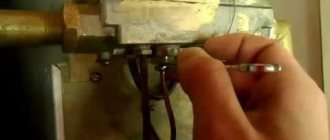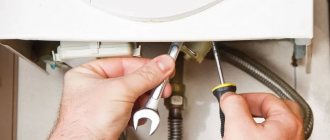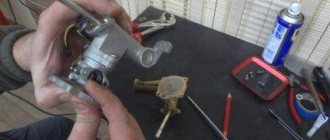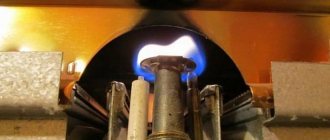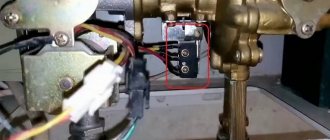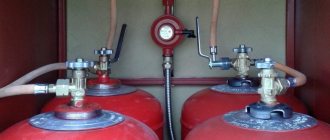You can determine why the gas water heater goes out and fix most problems in the water heater yourself.
Malfunctions are manifested in the following:
- the flame goes out immediately after switching on;
- the column goes out during operation;
- attenuation occurs when switching to the “shower” mode or mixing hot water with cold;
- the burner continues to work after turning off the water.
In each of the described cases, malfunctions are caused by different reasons.
Signs of improper operation of the igniter (wick)
Why does the wick go out in a geyser - reasons
Let us remind you that the igniter is designed to ignite the main combustion system when water is supplied. The flame occurs as a result of the combustion of a warm air mixture. The igniter heats the thermocouple by physically reaching the main burner.
If the wick goes out, this process fails. In order to prevent overheating of the technical components of the column and, most importantly, gas accumulation, an emergency shutdown of the gas supply is triggered. As a result, the wick goes out automatically.
It is possible to understand that a gas boiler needs extraordinary maintenance without professional knowledge. The consumer can easily verify this by noticing:
- predominance of yellow and orange glare of the flame. Normally, the color of the fire is blue with an acceptable inclusion of yellowness of approximately 10%;
- excessively noisy operation of the equipment. There will not be absolute silence when the speaker is turned on, but strong crackling or rattling sounds indicate possible problems in some unit.
It must be remembered that in a column equipped with piezo ignition, the pilot light is constantly on. This is necessary for the device to operate instantly when the water is turned on. A non-working wick stops the gas supply to the column.
Not enough charge
When you open the water, you observe a normal flow, when you turn it on, there is a characteristic click, a spark is formed and everything is generally visually good. But there is one noticeable point: the burner itself in the gas water heater does not ignite. If you look through the window, there is no flame. This is the reason why there is no hot water. The owner does not have hot water, which causes a lot of inconvenience. This reason must be eliminated as soon as possible.
The reason for the malfunction and lack of hot water lies in a completely simple phenomenon. When the batteries stop working, the speaker stops functioning. It does not heat up and therefore the hot water supply stops.
The battery charge in the final stages is only enough to produce a spark. Therefore, visually you observe a spark, and there is also a noticeable click. But the battery energy is not enough to ignite the burner itself.
Replacing the batteries yourself is not difficult. To do this, you need to open the box with the batteries and take them out. Next, you should replace it with new, high-quality, powerful batteries.
More about batteries
Polarity in batteries matters. If you insert batteries without taking into account their polarity, the column will not light up. Batteries can sometimes get stuck in the pack, so keep an eye on them.
Replacement with new functioning batteries is carried out if two main criteria are met:
- The polarity of the batteries must be taken into account;
- The box intended for batteries must be closed until it clicks.
The batteries used in geysers must be standard D (in other words, barrel batteries). Salt options are not suitable because they have the ability to quickly fail. In most cases, alkaline batteries are used for geysers. They are otherwise called alkaline batteries.
There are often cases when a person purchases batteries, but they do not light the column. Here, too, several questions arise as to why even new batteries cannot cope with their functions. At this stage, the owner may also become confused and look for a completely different reason. In order not to find yourself in such an unpleasant situation, you need to wisely choose batteries for the operation of the gas water heater. There are a few tips to keep in mind...
Tips for choosing batteries
It is not advisable to choose too cheap ones. In this case, it is recommended to choose more expensive batteries (normal ones cost about 200 rubles). If you buy cheap ones, they most likely will not work properly, which means that in the future you will need to overpay
Therefore, initially purchase good quality expensive batteries; Pay attention to the expiration date of the batteries; As for brands, Duracell and Energizer brands are preferred. The battery must be alkaline or lithium
It will be more informative to use a specific multimeter tester that accurately determines the charge. Anyone can use such a tester; it won’t be difficult. This method is convenient and practical to use, and you can purchase a battery tester at any store.
The wick of the geyser goes out - reasons
How does a gas water heater igniter work?
The igniter may work for some time after turning on the water, but sometimes it goes out immediately.
Let's look at the reasons for equipment failure in these two cases. In general, the causes of equipment failure include the following:
- The thermocouple is faulty;
- the igniter is clogged with dust or debris;
- strong air currents knock down the flame;
- there is no draft in the chimney or it is insufficient;
- traction control sensors have failed;
- contact connections between the sensor and the power supply are broken.
- The thermocouple in most cases leads to equipment failures. Technically, this unit is a safety device for the flow of gas in the event of force majeure in an operating column. If the thermocouple is worn out or burned by prolonged exposure to flame, it will cause the wick to fade.
- The igniter does not necessarily become clogged to capacity. With structurally small holes in the burner wick, a few large inclusions are enough to cause problems with heating the thermocouple to standard temperatures.
- Problems with blowing out the flame occur when the column ventilation is incorrectly adjusted. But here it is important to accurately establish the cause, without mistaking weak draft for air exchange problems.
Now let's look at the causes of failures depending on the duration of the igniter.
Why does the pilot light go out immediately after being turned on?
What should I do if the pilot light goes out immediately after being turned on?
- The consumer manages to notice a small glimpse of the wick and that’s it - the igniter immediately goes out. Moreover, it is impossible to start the equipment again.
Interruptions in operation are caused by failure of the gas supply mechanism – servomotor/magnetic valve. Cleaning the unit is a temporary measure. Complete replacement of the valves will solve the problem.
- If the wick fires and goes out after about a minute, it can be stated that the gas control safety system has been activated. This occurs to prevent gas leaks, combustion products from entering the room, or to prevent rupture in the event of equipment overheating.
The reason lies, first of all, in an increase in the permissible temperature regime. In this case, the protective plates of the bimetallic control sensor repel each other, turning off the gas supply. Due to this, the column will not work in dangerous mode for more than a minute or two.
The wick goes out after a short time of operation of the column
Why does the igniter go out after a while after being turned on?
- Poor traction or its complete absence. Occurs due to malfunction of chimneys and combustion products entering the room - carbon monoxide. Control devices detect dangerous leaks, a protective shutdown of the equipment is triggered, and the column is temporarily blocked.
- The equipment smokes. In most cases, the problem is typical for speakers that have been in use for a long time. The norm for gas equipment is annual maintenance. If you neglect this rule, soot accumulates on the gas burner, clogs the heat exchanger, leading to carbon monoxide entering the room.
- Heat exchanger overheating. Each column has individual technical conditions of use. In most cases, the critical heating temperature is +55°. Exceeding the safe mode leads to increased water evaporation and the accumulation of hot condensate. Steam increases the pressure of the equipment, as a result of which the exchanger tubes cannot withstand and rupture. To prevent this, the manufacturer equips the columns with a sensor indicating the temperature in the heat exchanger.
- Poor water supply pressure, membrane wear. There are brands of gas boilers that are initially sensitive to this indicator. In this case, a “floating” flow, a faulty mixer or shower, or low pressure in the heating networks will lead to an emergency shutdown of the igniter.
Diagnostics and repair of gas instantaneous water heater
There are quite a few reasons for breakdowns. Having identified a failed element, it is better to entrust its replacement to a professional technician. But if there is no specialist nearby, and small children live in the house, you can carry out simple repairs yourself. Gas instantaneous water heaters from Electrolux, Junkers, Lemax and others have approximately the same design.
No traction
The lack of draft is checked by placing a lit match near the hole in the front part of the column. The retracting flame confirms the presence of draft. Otherwise you need:
- turn off the device;
- shut off the gas supply;
- check if there is a working powerful ventilation system nearby;
- make sure there is natural ventilation;
- determine whether the wind from the street is blowing into the chimney, preventing the removal of burnt substances;
- Clean the ventilation pipe from soot, soot and foreign objects, ensuring the free movement of air masses.
Steps 3-6 are performed to determine the cause of the lack of traction, in order to then eliminate it.
Weak pressure
If there is a weak pressure of hot water in the mixer, you can find the reason like this.
| No. | Diagnostic action | Critical Event | Malfunction | Solution |
| 1. | Check the cold water pressure at the faucet | The pressure is weak | Low pressure in the water supply system | Purchase and install a water pump |
| 2. | Check the hot water pressure at the outlet of the unit | The pressure is strong | Blockage in the hot tap (occurs as a result of water hammer due to frequent water outages) | Drain, clean or replace the faucet depending on the severity of the breakdown |
| 3. | Check the cleanliness of the water filter at the entrance to the column | Clogged | The filter element is clogged at the entrance to the column | Clean or replace the filter |
| 4. | Check the hot water pressure at the outlet of the unit | The pressure is weak | Blockage in the coil due to scale | Clean or replace the coil |
Diagnostics should be done starting from the first point in ascending order to eliminate the previous malfunction.
Strainer at the entrance to the column
Ignition system malfunction
One of the reasons that the wick does not light is dead batteries. This factor can be confirmed by the idle clicks of the piezoelectric element when hot water is turned on.
On a note! Amina products, in which the batteries run out very quickly, are especially susceptible to this breakdown.
Also, the wick may not ignite if there is a spark due to a breakdown of the cable or displacement of the ignition electrode. In this case, the cable will need to be replaced, and the electrode will need to be cleaned or its location adjusted.
Troubleshooting Tips
Why doesn't the gas heater light up? The proper operation of gas equipment begins with a competent choice of systems, since each manufacturer of geysers has its own “pain points”:
- for example, Bosch's thermocouple and igniter are initially weak. Why does the wick go out in a Bosch geyser? After 3-4 years of operation, the thermocouple needs global cleaning;
- Russian water heater Ladogaz VPG 10 is sensitive to water pressure;
- the popular “state budget” OASIS quickly begins to act up if the water quality is poor. All these points and upcoming operating conditions must be taken into account when purchasing equipment.
If troubles start, you need to act as follows:
- stop using the speaker;
- read the instructions to understand possible reasons;
- Call a gas service specialist.
Standards for servicing gas equipment require hardware fault testing, and the specialist must have permission to service networks.
Therefore, in case of any problems with heaters and boilers, the services of home craftsmen are not the best way out. Entrust repair work only to employees of professional certified organizations for servicing gas networks and equipment.
Here you can watch a video on how to repair a gas water heater igniter yourself:
Like any equipment, a geyser can break down, and one of the fairly common malfunctions is when the device suddenly goes out during operation. There may be several reasons for this problem, and to understand them, you should check each of the nodes in turn that can cause the speaker to turn off.
Removing burner blockage
Unfortunately, the burners in the Neva and Oasis gas water heaters (as in many others) are susceptible to blockages. Most often, this picture is observed in models with piezoelectric ignition. The cause of clogging is the accumulation of soot. It needs to be removed, for which the column is disassembled and the burner itself is removed from it. Any available tools are used for cleaning. After cleaning, the burner should be reinstalled and checked. If necessary, you can immediately clean the heat exchanger - its clogging leads to loss of traction and deterioration of heating.
Signs that the igniter (wick) is not working properly and why does it go out?
In columns with piezo ignition, the igniter must burn constantly, because when the hot water tap opens, it must ignite the main burner. The extinguishing of the igniter disconnects the column from the gas supply so that gas does not accumulate inside the device.
The pilot light may go out if:
- It is clogged with debris or dust.
- A flow of air acted on him from outside.
- The thermocouple has burnt out or worn out.
- There is no draft in the chimney.
- The traction sensor has failed.
- The solenoid valve is broken.
- No air access.
The most common cause of igniter extinguishing is a faulty thermocouple. Its main function is to block gas access to the column if the device is operating unstable. As soon as the pilot light goes out, the thermocouple detects the lack of heat and gives a signal to turn off the gas. However, if the thermocouple itself is damaged, it causes the wick to fade.
An equally common situation is when dust or some kind of debris gets into the igniter nozzles. Their diameter is very small, so even slight contamination can prevent the igniter from burning, resulting in the thermocouple not heating up enough.
The color of its flame indicates that there are problems with the igniter and it may go out at any moment. A normally functioning wick will have a flame that is 90% blue and may include some red flecks, and the tip may be yellow. If the pilot flame is predominantly yellow or orange, the wick is not working properly and the thermocouple will not heat up enough, causing the burner to go out.
For other possible reasons for the igniter fading, see the following video.
Troubleshooting new equipment
New equipment may also experience various problems. Most often they manifest themselves in the operation of the flow sensor, in the operation of the candle, or in the power system. Let's take a closer look at these problems.
Column microswitch failure
Often the problem with a loud bang during ignition is the insufficient discharge of batteries, which provokes the inability to instantly ignite the gas-air mixture.
The power supply is connected to the control unit via special microswitches, which are responsible for generating a signal to activate the ignition when the DHW tap is opened. If the signal arrives at the wrong time, this causes the problem. This malfunction occurs most often due to oxidized contacts. The microswitch cannot be repaired; it will need to be replaced.
If the microswitch breaks down, repairs cannot be carried out, since this system will have to be completely replaced
Flow sensor malfunction
Often the problem with popping is the flow sensor. It is located in the input circuit. A signal is sent to the control unit controller indicating the presence of liquid in the pipe. The data instantly activates the ignition system. Intensive use of this element creates an increased risk of breakdowns. For example, contact groups can be oxidized.
Such sensors are most often manufactured in a non-separable design, therefore, if a problem occurs, they cannot be repaired and must be replaced.
Working candle offset
The problem may be with the spark plug. After applying voltage, it provokes the formation of an electric spark. Modern candles are made in such a way that they can last for a long time. Element failures are rare, but they do happen.
The most common occurrence is that the ignition device is displaced relative to its nominal position. It can occur as a result of repeated heating and cooling. Such processes are associated with changes in the dimensions of individual structural elements. As a result of adjusting the position of the spark plug, the spark parameters become normal, and extraneous noise completely disappears.
Incorrect operation of the ignition retarder
A rare breakdown is considered to be incorrect operation of the ignition retarder. When disassembling the column, you need to remove the water regulator. On its cover there is a hole in the bypass channel, in this hole the ball is located. The adjusting screw determines the position of the ball.
If, when shaking the lid, you hear the sound of a moving ball, then you should not manipulate this part further. If there is no knocking, then you can move the ball using a thin copper or aluminum wire through the passage channel hole, which is located in the regulator cover.
Most often, the retarder is a ball of metal or plastic that blocks part of the bypass channel in the water regulator. In most column designs, this moderator is located in the boss of the water regulator cover.
As a last resort, you will have to resort to the procedure of parsing the element. It must be said right away that the external screw does not affect the position of the ball in any way.
The inner screw must be removed very carefully. You should first remember its initial position, and also clearly determine the number of revolutions by which this screw is screwed in
This will allow you to maintain the required location of the element (ball) during subsequent assembly.
After repair work, be sure to check all connections to completely eliminate leaks of both water and gas. All connections must be treated with a sealant to ensure tightness. After which you can put the casing in place and use the column as usual.
Causes
Column lights up and goes out immediately
A sudden shutdown of a dispenser that has been running for only a couple of minutes is most often caused by the emergency activation of a sensor that detects a gas leak. The device reacts to a dangerous situation by opening the thermocouple, causing the equipment to shut down.
The following video demonstrates how you can deal with this problem yourself.
The speaker goes out after a while
The reasons for this situation are the following problems:
- The draft sensor triggered because it detected that there was no draft in the chimney. This can happen due to blocking of the ventilation shaft with soot or a foreign object, as well as due to a lack of air flow into the room, for example, due to the installation of plastic windows. Another reason for missing draft is contamination of the heat exchanger with soot. In addition, it is possible that the sensor itself has failed.
- The flame sensor tripped when the main burner went out. Although rare, the burner can go out due to a sudden strong gust of wind. But much more often, its attenuation is associated with insufficient water or gas pressure, clogged mesh filters, and also with the formation of excess scale inside the heat exchanger. The burner shutdown also happens when the diaphragm in the water unit wears out.
- The gas valve has tripped if the gas pressure in the network has dropped or the heat exchanger has overheated.
- The batteries that power the automatic ignition column have run out.
Internal breakdowns
Now let's see what undesirable phenomena can occur inside the column itself:
Water circuit
Most often you encounter the following problems:
- The “original” filters included in some speakers are clogged.
- The flow area has decreased due to scale deposits.
Solid deposits, commonly referred to as scale, are formed by magnesium and calcium salts dissolved in water. The higher the water temperature, the higher the rate of scale formation, so the heat exchanger is the first to suffer from this problem. Its thin tubes clog very easily, resulting in a drop in pressure with all the consequences described above.
Today, a number of effective products are produced to clean the pipeline from scale. If a special composition for geysers is used, the heat exchanger does not need to be dismantled. It is enough to disconnect the supply pipe from it and drain the water by opening the hot water tap on the mixer.
Gas water heater water circuits
Then a rubber hose is secured to the inlet pipe of the heat exchanger using a clamp, into which the reagent is poured through a watering can. You need to pour it slowly, otherwise the product will splash out due to a violent reaction.
Descaling products contain very aggressive components, for example, hydrochloric acid. When working with them, you must carefully follow safety rules and use protective equipment - gloves and goggles.
After a 2-hour soak, the supply pipe is again connected to the heat exchanger, the root valve is opened and a certain amount of water is driven through the column.
If you couldn’t get a special product for speakers, you can use any, but then the heat exchanger will need to be removed and washed separately. Otherwise, an important element of the column - the aluminum gearbox - may be damaged.
If for some reason you cannot purchase a factory-made reagent, use a folk remedy - a solution of 100 g of citric acid per 0.5 liter of water.
Ignition system
In some columns, the spark to ignite the burner is generated by batteries - this is the so-called. electronic ignition.
The reason for the “strike” declared by the water heater can be very simple - the batteries are dead and need to be replaced.
The igniter may go out due to the fact that the ignition button was not held down long enough (less than 20 seconds) - the bimetallic plate did not have time to heat up.
Smoke removal system
Soot build-ups can form not only in the chimney, but also inside the column - on the heat exchanger. It needs to be cleaned periodically.
In turbocharged engines, the cause of poor draft may be a malfunctioning fan.
Modern instantaneous water heaters are very different from outdated models, so before purchasing you need to study the main characteristics of the equipment. : recommendations from experts and review of models.
We will consider the technology for pumping a well after drilling in the article. And also read useful tips on choosing equipment.
Automation
The most common type of automatic equipment that fails is the rubber membrane in contact with water. It may become deformed or crack. This element needs to be replaced.
When choosing a new membrane, give preference to silicone-based products - they are the most reliable and durable.
The traction sensor also fails relatively often. To check its functionality, you need to measure its resistance by connecting a tester to the terminals. The device should show “infinity”.
Reasons for column attenuation after ignition
When identifying the cause of a malfunction, it is important to pay attention to two points: how the igniter goes out (are any extraneous sounds heard); this happens immediately after ignition or already during the combustion process.
Reason #1 - failure of the flame ionization sensor
If the device turns on and goes out, the ionization sensor is 70% to blame.
This element is constantly in contact with the flame. The ions produced during the combustion process are attracted to the sensor and produce a current. If there are enough ions, the device works. If there are few of them, the column does not function.
- the burner went out 3-5 seconds after ignition;
- when restarted, the device operates longer;
- You just need to start the device several times and it is already functioning normally;
- problems appear only after a long break.
It is necessary to inspect the wiring that runs from the part to the control board. Why do we check all contacts? Then unscrew the holding screws and place the heating electrode at the hottest point of the flame.
This technique can extend the life of the sensor by another year. If everything is in order with the contacts and connections, the element needs to be replaced.
Reason #2 - the membrane of the water unit is worn out
A polymer part must have sufficient elasticity. Over time, this property is lost - the element becomes hard, cracks, and becomes overgrown with scale.
If the element becomes unusable, the heater will go out. It is necessary to inspect and replace the membrane, if necessary, with a more durable silicone one.
Reason #3 - the wick is clogged with dust
In models with an igniter, this part often becomes clogged. The flame becomes weak and a yellow tint appears. But a change in the color of the flame may also indicate a lack of air in the gas-air mixture.
The result is that the device is either completely unable to ignite the burner, or performs its function after a large volume of fuel has been supplied. In the latter case, a characteristic bang is heard.
To clean the element you will need two screwdrivers (Phillips, slotted) and an adjustable wrench.
- We remove the case - pull out the adjustment knobs, unscrew the bolts in the corners from the bottom, lift and remove the cover.
- We unscrew the draft sensor tube and the one that supplies fuel to the wick.
- We unscrew the screws and disassemble the structure.
- We clean the nozzle, blow out the tee, and assemble it.
There may also be a blockage in the draft sensor, which causes the igniter to smoke. After removing dust and dirt, the pilot light should burn with a stable blue flame.
If desired, all parts of the structure can be washed. But don't forget to dry them well before assembling.
What other reasons are there for extinction?
Failure of the gas water heater can also be caused by these elements.
Outdated membrane
The polymer material from which the membranes are made has sufficient elasticity, but after many years of use it disappears and the element becomes rigid, and it is possible that cracks or lime deposits may appear in it. Such defects will not allow the gas water heater to work regardless of how the tap is opened. Therefore, it is worth removing and inspecting the membrane: if its condition causes concern, a replacement for this element should be found as soon as possible.
Ignition system and piezo element
In devices that do not have an igniter, its functions are performed by electronic ignition, where the spark is generated by batteries. Perhaps the fault lies with them, since they are not always able to work for a whole year. In other geysers, a piezoelectric element driven by a water turbine is responsible for producing a spark. Such an ignition system will not help if the water pressure is low.
A regular igniter is also at risk of clogging; this can be easily determined by the yellow color of the flame. If the burner ignites with a loud bang, this is your case. After cleaning the element, everything returns to normal.
The shower turns on - the speaker goes off
If the water heater only turns off when the shower is turned on, then it is entirely its fault. The reasons may be:
- The mesh filter installed in the shower head is clogged.
- When the watering can becomes clogged, the water pressure decreases. You can try to unscrew it. If the column starts working, the reason has been found.
- The inner rubber pipe of the hose has become twisted, blocking the flow of water.
Why does the speaker turn off during operation?
If the gas water heater lights up normally, but for some reason goes out during operation, this may indicate that the device’s security system is functioning properly.
The column design has a sensor that is triggered when the internal temperature rises. There are two plates inside the system that repel each other, stop the power supply, and turn off the column. This happens when your core temperature rises quickly and uncontrollably.
You can check the sensors by resistance. A working part shows an infinity sign. When a different value is displayed, we call a technician.
If the device works for a long time and then turns off, check the settings. Sometimes users accidentally set it to turn off automatically after a certain time.
What else causes the shutdown:
- poor water or gas pressure;
- broken contact between the thermocouple and the solenoid valve (you need to clean the contacts and tighten the connections);
- oxidation of the power supply contacts, when the device clicks but does not light up.
It is also useful to check the batteries. Standard replacement of power supplies is carried out every six months. Batteries hold a charge longer.
Traction is poor or completely absent
The accumulation of combustion products is most often associated with clogging of the chimney with soot, soot, and debris. When there is no traction or it is insufficient, the work is not carried out.
Design and principle of operation
Schematically, the installation consists of a heat exchanger, a coil around it, through which water flows, a heating burner and an ignition system . In addition, the dispenser structurally performs the following functions: burnt gases are discharged through the manifold through the chimney, the gas valve regulates the supply of blue fuel, and the control unit records and changes the main parameters. All this is enclosed in a single housing and is a gas water heater, which is additionally equipped with a system of sensors that ensure safety and stop the product in critical situations.
Before operation, the column is connected to water and gas pipes. During operation, water flowing through the coil heats up and flows out through a pipe connected to the mixer.
Important! Unlike a boiler, the column does not have a tank in which liquid accumulates. It heats running water by burning gases.
Other sources of the problem
Let's look at other problems that cause the problem of column attenuation after ignition.
The fading of the wick may be due to the presence of powerful ventilation near the column. Exhaust air is drawn into the ventilation, which leads to attenuation. It is necessary to turn off the ventilation or turn its power down to minimum while the gas heater is operating.
For the same reason, you should not place a powerful hood next to the column. During its operation, sensors may be triggered, diagnosing a malfunction.
Sometimes the reason is hidden in the lack of natural ventilation. It is necessary to open the window or install a supply valve.
The wick can also be extinguished in models with piezo ignition. The button must be held for at least 10 seconds.
Also, during operation of the heater, it is not recommended to mix hot and cold flows. This leads to a drop in pressure in the line and damping of the wick.
The problem is solved by adjusting the indicators to a comfortable level and reducing the pressure with a special handle. If you still have to mix water, you need to leave the hot stream as the main one.
Attenuation may be caused by a malfunction of the solenoid valve or servomotor. Only calling a specialist will help here.
Boiler problems
All systems have been checked, but there is still no heat? So, the problem is still in the boiler itself. Let's figure out why it doesn't work. Malfunctions may appear as follows:
- The burner does not turn on or burns weakly
. The injectors may be clogged. They can be cleaned with a soft brush or thin wire. In addition, air could get into the gas line (especially if the connection unit was disassembled). Usually in such cases the gas boiler is blocked and an error code lights up on the display. It is necessary to restart by resetting the lock (how to do this is written in the instructions); - The burner does not turn on when trying to manually or automatically ignite.
Perhaps the gap in the ignition electrode is broken, contact with the current-carrying wire is lost, or the air supply filter to the burner is clogged. It is quite difficult to adjust the gap yourself, but cleaning the filter and checking the wire connection is quite possible; - The burner goes out after burning for some time.
It is possible that the ionization electrode is dirty, the gap in it is broken, or the connecting wire is unsoldered. You need to do the same as in the previous case; - Flame separation
. With such a malfunction, the injector makes a lot of noise (or a characteristic whistle is heard from it). It is necessary to adjust the gas pressure at the igniter. Separation is also possible with excessively high draft and increased supply ventilation (air blows out the flame in the burner). This situation can arise, for example, if the chimney pipe is too high; - The boiler makes noise and switches off spontaneously
. The cause may be a breakdown in the pump or built-in fan (for turbocharged models), failure of the thermostat (water boils), flame separation or breakthrough.
Hot water supply, without a doubt, can be considered a prerequisite for a comfortable life, therefore the occurrence of interruptions in the operation of the gas water heater requires the most urgent measures to be taken.
But you shouldn’t immediately rush to the phone and call a repairman, because the cause of the breakdown may well be trivial and easily fixable even by the user.
Let's try to figure out why the geyser goes out and in what cases the owner himself can restore its functionality.
The main working elements of the gas water heater are:
- gas-burner;
- the heat exchanger located above it is a long coiled tube in which the water flowing through it is heated.
Auxiliary components of the gas water heater include:
- Ignition device:
can be electronic (generates a spark in one way or another) or have the form of a pilot burner (pilot or wick) that burns constantly. In old speakers, the igniter had to be lit with a match. In modern ones, a piezoelectric element is installed for this purpose, which the user activates by pressing a special button. - Water-gas unit:
consists of an interconnected membrane (installed in the water supply) and a gas valve (installed in the gas path). As soon as the user opens the tap and water flows through the column, the membrane bends and opens the gas valve, thus supplying gas to the burner. - Safety automation:
consists of several sensors and a special solenoid valve in the gas path, to which these sensors are connected mechanically or. If deviations occur in the operation of the column, the corresponding sensor will close the valve, thereby turning off the device. In columns with an igniter, a thermocouple is also connected to this valve, heated by the igniter flame. It is triggered when the pilot burner goes out.
Ways to prevent malfunctions
When purchasing a device, you should pay attention to the minimum water pressure required for the normal functioning of the device. The passport data must be compared with the water pressure in the apartment.
For the column to work properly, you must:
- carry out preventive maintenance once a year or more often;
- inspect the chimney a couple of times a year and clean it, if necessary;
- clean parts from scale and soot;
- provide adequate ventilation.
And don’t forget to change the batteries on time.
Elimination of traction disorders
To test traction, try using an ordinary match. Bring it to the chimney and determine if there is a draft, then the flame will deviate towards the chimney.
If there is no draft, the gas water heater will not light and users will not receive hot water. Many dispensers are equipped with draft sensors, and if they show insufficient draft, ignition will be impossible. Situations are possible when the flame lights up and immediately goes out - this is due to the fact that the combustion products simply have nowhere to go, they remain in the combustion chamber, and the flame goes out due to lack of oxygen.
Lack of draft will require an inspection of the flue gas collector and the chimney itself. If there are blockages here, they can interfere with the normal passage of combustion products. The column perceives this as a lack of traction and does not allow the gas to ignite (or the gas goes out immediately after turning on). Unfortunately, you will be able to independently check only the part of the chimney that is visible before entering the wall - further work must be carried out by specialists . If the house is private, you can try to figure out the chimney yourself.
Checking the column solenoid valve
If the help of a paper clip does not help, check if the solenoid valve, which has a resistance of approximately 0.2 ohms, is working. They check it in the following way: apply a voltage of 20-30 mV to the winding at a current of 100 mA. This mode is easily created by any AA battery or battery and 100 m resistor. Light the wick and remove your hand from the gas control knob. The wick should continue to burn. When the battery is disconnected, the flame should go out. If these conditions are met, it means that the solenoid valve is working. Hence the conclusion: the thermocouple is broken. If you cannot find a short circuit or bad contacts by external inspection, it is recommended to replace the thermocouple.
Ignition repair
Try cleaning the air supply hole and the nozzle with a thin wire, your igniter should work again.
Sometimes, over time, the igniter nozzle can become clogged with soot, and the flame becomes insufficient and the fire may not ignite and go out. Gas accumulates and an explosion may occur. The igniter needs to be cleaned urgently.
It may also be that the pilot burner is half yellow when it should be blue. This happens due to a lack of oxygen in the gas mixture. Soot is released, which settles on the heat exchanger. In this case, it is necessary to clean the hole in the igniter for supplying oxygen to the burner from dirt.
To remove the igniter, you need to unscrew the nut that secures the gas supply tube and unscrew the two outer screws. Next, the bar is pulled towards itself and raised up. The jet must be clamped in the igniter of the tube; when it is released, it falls out. Clean the air supply hole and nozzle with a thin wire - your igniter should work again.
The most important thing in troubleshooting a problem when the pilot light of a gas water heater goes out, the thermocouple and other parts of your burner fail is to be extremely careful. If you are not confident in your abilities and cannot troubleshoot problems yourself, then contact a specialist. It's dangerous to joke with gas!
Is it possible to turn on cold water when the water heater is running?
Doing this is strictly not recommended for several reasons:
- Manufacturers prohibit turning on cold and hot water at the same time, as stated directly in the operating instructions. You need to initially set a comfortable temperature that allows you to do without mixing. Opening the cold water tap affects heating and causes rapid failure of the water heater.
- The main reason why you cannot turn on cold water when the gas water heater is operating is that this malfunction leads to a rapid build-up of scale in the heat exchanger.
For ease of use, modern automatic gas flow-through columns have a “winter-summer” mode. The function helps to quickly change the heating temperature and reduce gas consumption.
